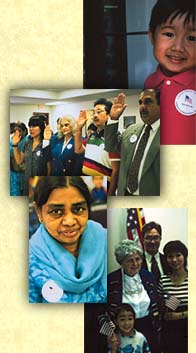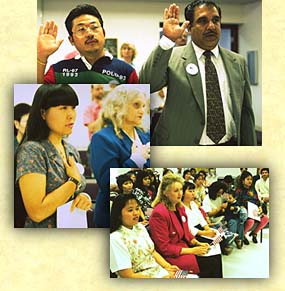LIBERTY TODAY
The Statue of Liberty was given
to the United States by France in recognition of the friendship established
between the 2 nations during the American Revolution.
It was originally intended as a
gift to celebrate the 100th anniversary of America's independence in 1876.
Raising funds to design, ship and construct the massive structure took
longer than anticipated, however, and the statue didn't find its home in
New York harbor until 1886.
Once there, it quickly became the
world's most widely recognized symbol of liberty. Immigrants streaming
into the United States by way of nearby Ellis Island were guided to America's
shores, in a literal and a symbolic sense, by Liberty's torch.
![]() Continue
Continue
The United States of America has
always been a diverse nation. Native Americans, Spanish Americans, African
Americans, British Americans, French Americans and Dutch Americans have
lived within the current bounds of the nation since the earliest days of
the colonies and before.
Immigrants have never stopped coming
to America. In the 175 years for which the U.S. Immigration and Naturalization
Service has been keeping numbers, more than 62 million new Americans have
arrived on these shores.
They have come in the wake of famine and political turmoil. They have come seeking jobs and land. They have come for personal and religious reasons. Almost 3 million came from Ireland in the 19th century. 5 million came from Germany. In 20 years from the turn-of-the century to 1920, more than 3 million Italians sailed beneath the torch of Liberty.
In the last 25 years, the
greatest influx of new arrivals has come from Asia and Central America.
Almost 6 million have come from the Philippines, from Korea, from China,
Vietnam, Cambodia and Laos. Another 3.5 million have come from Mexico.A
recent naturalization ceremony, held on the 4th of July in Apple Valley,
Minnesota, typifies the diversity of America's newest citizens. 22 immigrants
from a dozen different countries were sworn in. 
Louis Yung Fat Cheung and Jo Jo
Ho, husband and wife, had arrived from Hong Kong. Louis worked at a cousin's
restaurant in Minneapolis.
George Thomas Cherucheril had been
in the United States for 20 years, and worked for the Minneapolis Star
and Tribune. After the ceremony, he would hold dual citizenship here and
in his native India.
Olga Ivan Malashenko had been a
recent emigre from Kazakhstan. Like Mai-Houa Xiong Thor, who had come from
Laos, she left a country embroiled in violence and political conflict.
So too had Maria Valeria Gamauf,
who arrived in St. Paul, Minnesota 41 years ago from Yugoslavia, by way
of Austria.
The
ceremony was organized by Jean Crewson, a local INS official, who each
year hosts this event at the Apple Valley Community Center. The Church
of the Risen Savior Messengers singing group provided entertainment. The
Honorable Paul A. Magnuson, a federal judge from Minnesota, administered
the oath. A 4th of July parade through the streets of Apple Valley followed.
22 new citizens became part of the great cultural and ethnic mix of the United States of America. On the anniversary of the day that a new nation declared its citizens rights to "Life, Liberty, and the Pursuit of Happiness," these 22 were made a part of that original pact.
Like the more than 62 million immigrants
who had come before them, they have no direct ties with the men and women
who fought the American Revolution. They do, however, share with the founders
a belief in the human values upon which the United States was created,
and which are so eloquently stated in the Declaration of Independence,
in the Constitution, and in the Bill of Rights.
This makes them citizens of the
United States of America. Its history is now theirs. Like all the rest
of us, they have, in spirit, dumped tea in Boston harbor, come running
with muskets to Lexington commons, marched with Washington to Yorktown,
and sat in Philadelphia through the summer heat of 1787, creating the outline
of a new nation that would embrace people like them more than 200 years
later.